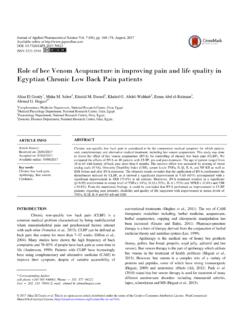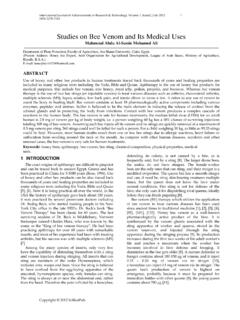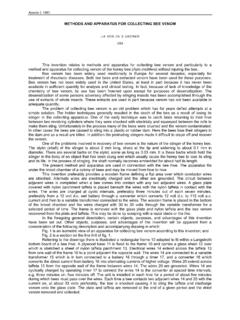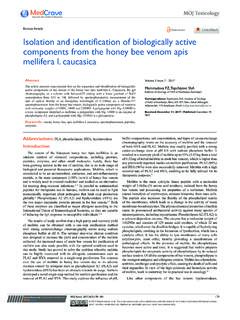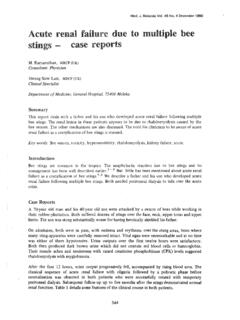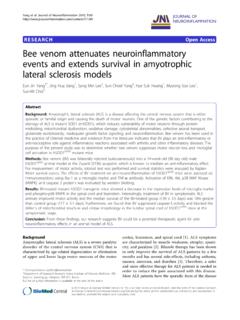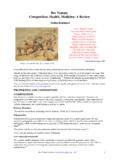Transcription of ANTIBACTERIAL ACTION OF A BEE VENOM …
1 USNROL-TR-67- 10114 August 196700 ANTIBACTERIAL ACTION OF A BEE VENOM FRACTIONf(MELI TTIN ) AGAINST A PENICILLIN-RESISTANTSTAPHYLOCOCCUS AND OTHER MICROORGANISMSbyJ. F. FennellW. H. ShipmanL. J. NAVAL RADIOLOGICALDEFENSE LABORATORYSAN FRANCISCO CALIF RNIA 94135o-22 EXPERIMENTAL PATHOLOGY BRANCHL. J. Cole, HeadBIOLOGICAL AND MEDICAL SCIENCES DIVISIONE. L. Alpen, HeadADMINISTRATIVE INFORMATIONThis work was accomplished under the Bureauof Medicine and Surgery Work Unit This study was supported through fundsprovided by the Bureau of Medicine and AVAILABILITY NOTICEThis document has been approved for publicrelease and sale; its distribution is un] !'[ ..;.." ,.F i_TII/ P. Cooper Campholl. CAPT USNT echnical Director Commanding Officer and DirectorARBSTR~ACTBee VENOM and its melittin fraction were shown to have anti-bacterial activity against a penicillin-resistant strain of Staphaureus (strain 8)).
2 This activity of bee VENOM and melittin wepdemonstrated by a method similar to that used for plate sensitivitytests. Both whole bee v'enom and its melittin fraction were alsoable to inhibit the growth of 20 of the 30 different. bacteri.,,organisms tested. More Gram positive organisms (86%) were sensitiveto bee VENOM and to melittin than Gram negatives (46%). The anti-bacterial activity of bee vcnom and melittin were of the same zones of inhibition created by bee VENOM and melittin were comparedwith those caused by penicillin, and the equivalent units of penicillinwere computed. The antibiotic potency of a single bee sting wasalso determtned. Among the Gram positives, the ANTIBACTERIAL effectof a 1:10 dilution of whole liquid bee VENOM was equal to that ofpenicillin at a concentration of to units/ml. The samedilution of bee VENOM when tested against Gram negative organisms com-pared to a higher range of penicillin values-93 to 1,700 Problem Previous studies from this Laboratory have shownthat bee VENOM is radioprotective for mice.
3 It is also known thatwhole bee venon exhibitt; ANTIBACTERIAL properties. The objectivesof this present work were to define the chemical fraction in beevenom responsible for the ANTIBACTERIAL ACTION . tu determP1- ittactivity against a varity of Gram positive and Gram uegaivcbacteria and to compare its ANTIBACTERIAL with a standardantibiotic, , Findings The ANTIBACTERIAL activity of bee VENOM and itsprinciple component, melittin, was measured. Whcle bee VENOM andits mrlittin fraction (obtained by column chrome ography) showedsimilar activity levels; they inhibited the growth of 86" of theGram positive organisms and 46% of the Gram negatives. A comparisonwith penicillin was made in order to estimate the potency of the beevenom and melittin. Among the Gra' positives, the antibacterialeffect of a 1:10 dilution of whole liqcid bee VENOM was equal to thatof penicillin at a concentration of to units/ml.
4 The samedilution (f bee VENOM when tested against Gram neg. tive organisms com-pared to a higher range of penicillin values-93 to 1,700 ability of bee VENOM tc increase the radiation resistance ofmice was recently reported from this Laboratory (1). Studies P-now uncerway to dete'-, ie the fraction(s) of bee VENOM responrible forthis effect. Pursuant to this study, it was noted that one of .nz. -,!!-n, fti!2- tT culture microorganisms when all of thefractions were accidently contaminated with bacteria. This observationled to an tvaluation of the potential bacteriontatic and!or bacterlocida]characteristics of bee VENOM and of melittin. Melittin is the largestsingle component (by weight) of bee VENOM ; it is a polypqld(& of molec-ular weight 2850, and evidence suggests that in bee VENOM it existnmostly as a tetramer (2).In 1941 Schmidt-Lange discovered that bee VENOM wan ANTIBACTERIAL (3).))
5 This observation was extended by Ortel and Markwardt in 1955 (0,5).They measured the effect of bee VENOM against thirtcen Gram positiveand nine Gram negative bacteria and showed that the Gram positiveriwere the nost the present work, we vere interested in deter-mining whethermelittin itself was antilbacterial, and the range of its activity. Inthe course of these studies it was found that a penicillin-resistantbacterial species, aj__ h. aureus strain 80, was -;ensitive to the anti-bacterial ACTION of IMATERIALS AND ME7 HODSBee VENOM : VENOM was collected by the method of Benton, Morse,and Stewart (6). The crystalline VENOM was pooled and separated intocomponents on a Sephadex G50 column (2).Melittin: To establish the purity of the melittin fraction theultra- v cl- absorption -nectrum of melittin was obtained prior to andafter the experiments. A comparison of the two spectra showed themelittin had not been degraded by air : Most of the organisms tested were isolated from variousanimal sources.
6 The three strains of Staphylococcus aureus wereobtained from the collection of Drs. V. Hurst and V. Sutter of theUniversity of California Medical Center. The 9 unidentified organismswere isolated from the gastro-intestinal tract of a strain of miceroutinely used in the laboratory. A total of thirty organisms weretested -fifteen Gram positive organisms and fifteen Gram organisms to be tested were inoculated from stock culturesinto 10 ml of Drain Heart Infusion (BHI) broth, and incubated for 18hours at 370C. (An exception to this was Pseudomonas fluorescens whichwas incubated at 250C).Test Method: The method used in testing the ANTIBACTERIAL activityof bee VENOM and melittin was similar to that used for standard anti-biotic testing. Fresh B}HI agar plates, dried in an incubator at 370 Cfor one-half hour, were flooded with a suspension of the organism. Theexcess fluid was removed with a Pasteur disposable pipette, and theplates allowed to air dry.
7 Three plates per organism were used in discs were made from #7 filter paper. These discsmeasured approximately 7 mm in diameter, and held 10 pI of di-c 4-v A in the bee vvr_-i or l~tta, tedl soiuttonand placed on the dry plates with sterile forceps. The plates werethen incubated overnight. The diameter of the zone of inhibition Wasmeasured and the mean values order to evaluate the ANTIBACTERIAL effect of whole beevenom and u, the melittin fraction, their inhibitory effect at a con-nentration of 30 mg/ml was compared to that of a standard antibiotic,Penicillin. Ten-fold dilutions in sterile uster were made of bufferedPotassium Penicillin G -200,000 units (Squibb). These dilutions weretested in the same manner as the bee VENOM and melittin of the thirty organisms used in these experiments mos testedseveral times for its sensitivity to whole bee VENOM and to the melittinfraction.
8 The results of these tests are given in Tables I and Gram positive organisms (Table I) proved to be more sensitiveto the test 6uostanc-s than the Gram negatives (Table II) to ICOMPARISON OF EFFTCT OF WH0LE BEE VENOM (30 mlg/m) ANDOF THE MELPTTIN FRACTION (JO TW,/ml) ON GRAM POSITIVE ORGANIStVORGANISM ZONE OF INMIIBITYON(Diwan., ~bee VENOM fecslis liLuelaciens aureus -Strain 3A "t " " 53 sp. pos. cocci #1 8d. pos. rods #1 0 04 o o4 TABLE IIC0 MPAIU';0N OF kYFUW'r 01F WHOLE PMk VENOM * (30 Mg/mi)AND 0i. THE M TI~Nrr FRACTION (30 mg/m1~) ONl GRAM' NEGATIVE ORGAXIISW,3OH~N~?'Bee Ven'omn MelittinAeontra~ cloacae ~thesda -k ierup ..Citroba~ter freundli 0 0 Citrobajctes- freundii (eaberrart) 0 0E. coil 0 0E'lma Pol ymo -ha mrn~rb~l ir. 0 0 Proteup m-rcani fluorrescens 0 0 Pneudomonar %altophilia ,!)
9 1Th derby 0 0 Salmonella pswport marescens 0 0In most case, a slightly h!gher inhibitory effac, "-s achievedwith the melittin firattion. , this difference is not large'enough to be considertd significant, and "t can therefore be concludedthat th ANTIBACTERIAL activity of the melittin fraction is )f the samemagnitude as that of whoie bee zones of inhibition tY bee VENOM or melittin ax-,the same size for most sensitiv* organisms with the average being few cultures shoved a greacrer sensitivity A .the two substances -Coryeacterium sp., Gram positive rod #", ane Aim1 conpari sion of the activity of melitin and penicillin againstthree strains of jtaph aureus is shown in Table 1ll. A)", three strainswere sensitive to mtlittin to the same degree ur-ila tne magnitude ofreo~porxe to ptnJcillin varied greatly with the strain und the con-zentration. The experiment&l.
10 Technique previously mentioned was vsr!redslightly for one experiment. The test cultures were incubated- f'r 5hours in a water bath rather then 18 hours in an incubator prior toupe. It vws thou .ght that irith a lighter lawi. the zones of indibitionwould t larger ant more easily measured. However, there was no signi-ficant difference between th3 zone- created on the 5 hour culture andthose on the 18-hotr &dta expressinrg te equivalency of the number of units ofpenicillin to 1 mg /mi cf bee VENOM is given in Table IV. Only thoseorganisms sensitive to both oee VENOM and penicillin are ccusideredin this table. It is not surprising to find more Gram positive IIICOMPARISON OF ANTIBACTERIAL ACTIVITY OF ANDPENICILLIN THM STRAINS OF STAPH. AUREUSS taph aureus Melittin (mg/ml) Penicillin (Units/ml)30 50,000 5000 500 50 5 3A 35 32 27 22 13 0"53 18 13 0 0 0 0"80 8,3 0 0 0 0 0 0-7 TANSl IVCOMPARISON OF INRIBITOEY ACTION OF PUICILLIW AnD OF PEE VUMO4(and mlittin)UITS/um or PmcnLI zuiVALumTO 1 mgJml of WHOLE BE VENOMOROArISm (or melittin)Gram NegativeAerobacter cloacae 1,700 Bethesda -ballerup 93Hi__ poln2rba 9306a ~lne la newtort 93 Gram Positive Aph.










